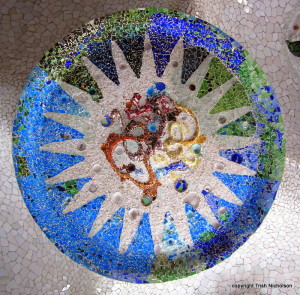 For writers? – But Gaudi was an architect. Indeed, an exceptionally creative one: it is from his talent for harnessing imagination to his purpose with perseverance, trust and hard work that we as writers can gain so much.
For writers? – But Gaudi was an architect. Indeed, an exceptionally creative one: it is from his talent for harnessing imagination to his purpose with perseverance, trust and hard work that we as writers can gain so much.
Gaudi is the guardian of my muse and, as this may seem unusual, I will try to explain why. An intensely private man whose personal life is largely unknown, Gaudi wrote little, but I have picked four quotations which inspire me as a writer.
Why should an architect not inspire a writer? Creativity cannot be put into pigeon holes: it spreads deliciously into everything like warm maple syrup dripping from a pancake, smudging fingers and leaving traces on the tablecloth for even the ants to carry away. Every one of us is born with a faculty for creativity – we have only to use it.
In the same vein, there is nowhere that art does not have significance:
“Science is a hamper which is being filled with things and more things that no one can manage until Art puts handles on the hamper and takes from it exactly what is necessary to perform the deed.” (Antoni Gaudi).
The gift of art to strip away incidental matter; to focus on the essential and express its core is precisely what we aim to do in a good story. No topic or theme is out of bounds to a creative writer nor immune to our attention in aiding deeper, more powerful understanding – that is the exquisite art of story.
As a deeply religious man, whose Catholic faith was more Franciscan than doctrinaire, Gaudi viewed his talent as the product of collaboration with all of God’s creation. He studied landscapes and the natural forces that formed them, applying the same principles to his designs – these are the ‘origins’ he refers to:
“But man does not create, he discovers… originality consists in returning to the origin.” (Antoni Gaudi).
We are not required to share Gaudi’s Christian fervour to gain benefit from his insight. The essential meaning I draw from these words as a writer is to seek inspiration from life around me, and originality from within – from experience, particularly inner experience and self-knowledge. Screen-writer and teacher, Robert KcKee, expresses this idea in his book Story: we do not ‘create’ characters; portraits of complex character in writing come from our deeper selves – a writer discovers them from the depths of his or her own personality.
And it is not only characters: we find our most potent writing ‘voice’ when drawing deeply on the ideas we care most about.
“With two rulers and a cord one generates all architecture.” (Antoni Gaudi)
In interpreting these words, I assume all that has gone before regarding imagination and originality because the point is that with these instruments a structure is arrived at to carry, and be part of, an artistic creation. For all Gaudi’s outrageous flights of fancy, he was a master of structure: his buildings worked, performed their functions often in extraordinary ways. However rich our prose, ingenious our plots or complex our characters, stories must have structure, form, or they allow no purpose to our expression.
Gaudi also used his rulers and cords for experiential modelling of his concepts, trying out new materials, different proportions, drafting and redrafting until he was satisfied. So with the writer – playing with ideas, writing and re-writing, editing and polishing.
“Must work hard to overcome the difficulties.” (Antoni Gaudi)
This requires little explanation as far as its relevance to writing is concerned; we learn writing mainly by writing. Gaudi was obsessed with his work, chafing because he had done “nothing” – on Christmas Day.
The significance of the quote is that it was a diary entry on 25 November 1876. He kept no other diary and made entries in this one for only a couple of months – those following the deaths in close succession of his brother Franscesc and his mother, two years before he qualified as an architect. He had no need to coerce himself to work; rather it was an oblique reference to the fact that he sought to overcome his bereavement by further immersion in work.
As writers, too, we may at times seek consolation through the act of composition; express inner turbulence in the written word, giving it form that enables us to view it and understand it with greater equanimity. Sources of art, beauty and inspiration are everywhere, all around us and within us, take time to look…
[Source: Gaudi: a biography. Gijs van Hensbergen (2001) Harper Collins]
Storytellers have always sought originality by “returning to the origin” consciously or subconsciously. All our stories have threads leading back to all the fables, epics, myths, sagas and folktales that have defined our humanity since we first learned to tell each other tales. And their origins network cross the globe. You can read the story of stories, the history of storytelling in A Biography of Story, A Brief History of Humanity
If you would like to learn more about the book first, see the List of Contents and read the Introduction, see this post
And you can read a couple of Goodreads reviews here and here

Hi Trish,
You’ve done an excellent job in using Genius and Imagination to blur those hard-edged lines that many people–consciously or subconsciously–superimpose on the arts. Although I don’t entirely agree with Gaudi’s “man does not create, he discovers,” I strongly identify with his idea of returning to the origin. Wonderful post!
Hi Terre, sorry, I missed this. So glad you enjoyed it, and people like you who are creative in so many dimensions show vividly that art and creativity cross boundaries – artificial boundaries, as you say.